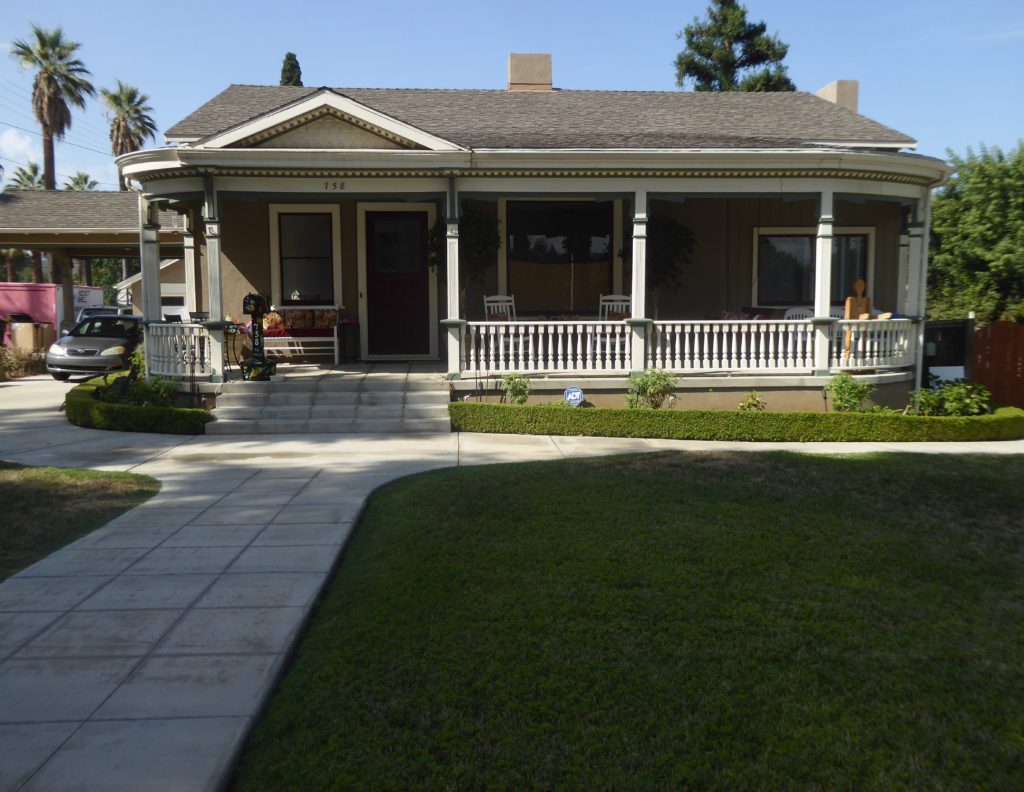
2021 HERITAGE AWARD RECIPIENT
The Redlands Area Historical Society, Inc.
John & Minnie Riddel Home
758 South Center Street
1894
John Riddel might not recognize the house he built in 1894. For a majority of the home’s lifetime, this once two-story Queen Anne at 758 S. Center has slipped through our consciousness as a one-story, mostly stuccoed version of its original self. Elements of the Victorian era remain, some hidden with others clearly visible to the discerning eye.
John Oscar Riddel was born on June 21, 1862 near New Haven, Connecticut where he resided until moving to California around 1890. The young man established himself in Redlands as prominent young businessman. According to Illustrated Redlands, Riddel spent four years as the assistant to Redlands City Engineer E. A. Tuttle. The brief biography reported that Riddel was “also engaged in growing citrus fruits, having nearly twenty acres in oranges and lemons. He owns the oldest grove in Redlands proper, a seedling orchard on the corner of Center Street and Olive Avenue.” The 1912 city directory also noted John was in the olive and olive oil business.
This Connecticut Yankee purchased 2 ½ acres from Lee H. Utt at Palm Avenue and Center Street in late November of 1893 for $3,300; in today’s dollars a little over $100,000. Construction began almost immediately. In early 1894 notices published in the Redlands Daily Facts indicated the framing was up.
As with Queen Anne houses of the late 19th and early 20th century, the Riddel house featured a steeply pitched roof, an asymmetrical facade, pointed pediment with dentil course, multiple textured siding materials, including half cove shingles, a one story asymmetrical porch with shed roof, ornamental posts, and spandrels in between the posts, and a dominant front-facing gable.
John Riddel married Miss Minnie E. Grant of New Haven, Connecticut on 18 April 1894 in an Episcopal ceremony in the home of her father and step-mother. Her father, George Miles Grant, was a successful New Haven contractor. The newlyweds arrived in Redlands on May 4, 1894 to their new home. They had one child, Charlotte Grant Riddel, born in Redlands on January 4, 1897. Charlotte would graduate from the Westlake School for Girls in Los Angeles. John and Minnie were active at Trinity Episcopal Church where John served on the Vestry. He was an election inspector, a member of the Redlands Country Club, Treasurer of Associated Charities, and on the board of the Redlands Commercial Company. In 1898 John placed ownership of the home in Minnie’s name. John died on September 10, 1926 and Minnie passed away the following year on November 20th. The two are buried in the Evergreen Cemetery in New Haven, Connecticut.
There have been a succession of homeowners and/or renters since Charlotte inherited the house following her mother’s death, including Charles and Katherine Longmire, Helen Bethel, the widowed mother of artist Worden Bethel, and the Rev. and Mrs. Clyde Stillion. Antonio and Mary Teixeira are listed as owners in 1939. The house remained in their family until at least 1950, followed by the Silva family and others. In 1970 the house on over two acres was listed for sale by owner for $39,000. Later, the property was reduced in size from the two acres.
It is a challenge to architecturally describe this house. While it retains significant vestiges of the original 1894 Queen Anne Victorian home, from a distance it is not unlike many post WWII stuccoed single story homes. A second look, a closer look reveals elements common to the Victorian – dentil courses, half cove shingles within the pointed pediment, and support posts more decorative than function when compared to the elephant posts of the Arts and Crafts and the California bungalow. Even the front steps and broad expansive porch are out of character for a mid-century home. In 1890s the steps were a purposeful tool to keep distance from the ground and the dust at bay. Patterned shingles, dentil courses, and balustrades do not fit the lines and simplicity from the second half of the 20th century.
Interior elements documenting the earlier history include the entry hall and dining room fireplaces, doors, the built-in buffet, double-hung windows with the original wavy or ripple glass, and features in the basement. The latter retains evidence of a horse stall once accessed through a large doorway at the back of the house. In 2020 the interior fire sprinkler system flooded portions of the home. The built-in buffet was dismantled piece by piece and meticulously restored. Discovered behind the mirror were historic newspapers dating from the late 19th century; a not uncommon practice of carpenters over 125 years ago who left these informal time capsules as a record to future generations.
The removal of the 2nd floor and attic remains a mystery. An aerial photograph dated 1938 and the fire insurance Sanborn map from the same year documents a two-story house. Bookend evidence from 1949 is an image by photographer Elmer Kingham showing 758 S. Center, now a one story, covered in the snow that blanketed southern California in January 1949. Sometime between 1938 and this rare winter wonderland event, the house was transformed from two to a one story. Was fire the cause? We do not know. To date no written documentation has revealed itself.
Chuck and Julie Mendoza purchased the house from Thomas and Tanie B. Donaldson in 1992. Their four children are the fourth generation of the Mendoza family to graduate from Redlands High School. Chuck is a Redlands native, former Cope Middle School teacher, and now a Professor of Education at Cal State San Bernardino. Julie is a graduate of the University of Redlands and a kindergarten teacher at Mission Elementary.
The Mendoza family cherishes their home. Original features are preserved while making sympathetic alterations and employing architects and contractors experienced working on historic structures. Shadows or ghosts from 1894 serve as indicators of original design elements. While working at the back of the house, a section of the wood balusters/spindles was discovered preserved under a stucco wall. These vestiges of the 19th century were copied to recreate the porch railing on the front and south side of the house. One section of the original clapboard siding is located on this south side porch. The use of stained and etched glass is a reminder of the Victorian era and the rich agricultural legacy of Redlands as depicted in windows by local glass artist Tom Medlicott.
The Redlands Area Historical Society recognizes and applauds Chuck, Julie, Katherine, Caroline, Allison, and Matthew for their stewardship of this unique, turn-of-the century architectural treasure.
Presented 27 September 2021
Research by – Steve Spiller, Karen Flippin, Marie Reynolds, & Dr. Marcus Paulson

